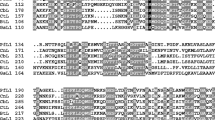Abstract
Polyhydroxyalkanoates (PHAs) are an important class of biodegradable polymers synthesized by a few bacteria under nutrient-limiting conditions. In this study, the lipase-catalysed degradation of PHA synthesized by Enterobacter sp. was monitored. For this, the lipase-encoding gene from Bacillus subtilis DI2 was PCR-amplified, cloned into a T vector system and sequenced. It was expressed in Escherichia coli DH5α cells, the recombinant enzyme was purified 24.25-fold, and its molecular weight was determined to be around 28 kDa. When PHA biodegradation studies were carried out with this enzyme, gel permeation chromatography showed 21.3 and 28.3 % molecular weight decrease and weight loss, respectively. Further, scanning electron micrographs revealed alterations in polymer surface morphology. Changes in molecular vibrations were noticed in the FTIR spectra. When the chemical shifts in NMR spectra were studied, a steep reduction in area under the peak at 1.57 ppm was observed. In the heating range of 30–930 °C employed during thermogravimetry analysis, the degraded sample showed a total of 45.82 % weight loss, as against 18.89 % for the native sample. The melting temperature (T m) of the polymer was also brought down from 126.22 to 118.18 °C, as inferred from differential scanning calorimetry. Lipase-catalysed chain scission reactions could thus be used to generate low molecular weight functional biopolymers with wide-ranging pharmaceutical applications, such as in sustained drug release.








Similar content being viewed by others
References
Bhuwal AK, Singh G, Aggarwal NK, Goyal V, Yadav A (2013) Isolation and screening of polyhydroxyalkanoates producing bacteria from pulp, paper, and cardboard industry wastes. Int J Biomater 2013, 1–10, Article ID 75282
Chen C, Yu CH, Cheng YC, Yu PHF, Cheung MK (2006) Preparation and characterization of biodegradable nanoparticles based on amphiphilic poly(3-hydroxybutyrate)epoly(ethylene glycol)epoly(3-hydroxybutyrate) triblock copolymer. Eur Polym J 42:2211–2220
Colak A, Guner S (2004) Polyhydroxyalkanoate degrading hydrolase-like activities by Pseudomonas sp. isolated from soil. Int Biodeterior Biodegr 53:103–109
Fiorese M, Freita F, Pais J, Ramos AM, Aragao C, Reis M (2009) Recovery of polyhydroxybutyrate (PHB) from Cupriavidus necator biomass by solvent extraction with 1,2-propylene carbonate. Eng Life Sci 9:454–461
Gumel AM, Annuar MSM, Chisti Y, Heidelberg T (2012) Ultrasound assisted lipase catalyzed synthesis of poly-6-hydroxyhexanoate. Ultrason Sonochem 19:659–667
Hauttecoeur B, Jolivet M, Gavard R (1994) Depolymerization, by a controlled chemical process, of beta hydroxybutyric lipid (or PHB) of Bacillus megaterium. C R Acad Sci Hebd Seances Acad Sci D 274(19):2729–2732
Horowitz DM, Sanders JKM (1994) Amorphous, biomimetic granules of polyhydroxybutyrate: preparation, characterization, and biological implications. J Am Chem Soc 116:2695–2702
Khanna S, Srivastava AK (2005) Recent advances in microbial polyhydroxyalkanoates. Process Biochem 40:607–619
Kimura M (1980) A simple method for estimating evolutionary rates of base substitutions through comparative studies of nucleotide sequences. J Mol Evol 16(2):111–120
Kuntanoo K, Promkotra S, Kaewkannetra P (2013) Biodegradation of polyhydroxybutyrate-co-hydroxyvalerate (PHBV) blended with natural rubber in soil environment. Int Sci Index 7(12): waset.org/Publication/16662 (2013)
Laemmli UK (1970) Cleavage of structural proteins during the assembly of the head of bacteriophage T4. Nature 227:680–685
Lauzier C, Revol JF, Debzi EM, Marchessault RH (1994) Hydrolytic degradation of isolated poly(b-hydroxybutyrate) granules. Polymer 35:4156–4162
Ma J, Zhang Z, Wang B, Kong X, Wang Y, Cao S, Feng Y (2006) Overexpression and characterization of a lipase from Bacillus subtilis. Protein Expres Purif 45:22–29
Motiwalla M, Punyarthi P, Mehta M, D’Souza J, Kelkar-Mane V (2013) Studies on degradation efficiency of polycaprolactone by a naturally occurring bacterium. J Environ Biol 34:43–49
Nguyen S, Yu G-E, Marchessault RH (2002) Thermal degradation of poly(3-hydroxyalkanoates): preparation of well-defined oligomers. Biomacromol 3(1):219–224
Obruca S (2010) Controlled production and degradation of selected biomaterials. Dissertation, Brno University, Czech Republic
Philip S, Keshavarz T, Roy I (2007) Polyhydroxyalkanoates: biodegradable polymers with a range of applications. J Chem Technol Biotechnol 82(3):233–247
Rahayu A, Zaleha Z, Yahya ARM, Majid MIA, Amirul AA (2008) Production of copolymer poly(3-hydroxybutyrate-co-4-hydroxybutyrate) through a one-step cultivation process. World J Microbiol Biotechnol 24:2403–2409
Rodríguez-Contreras A, Calafell-Monfort M, Marqués-Calvo MS (2012a) Enzymatic degradation of poly(3-hydroxybutyrate) by a commercial lipase. Polym Degrad Stabil 97:2473–2476
Rodríguez-Contreras A, Calafell-Monfort M, Marqués-Calvo MS (2012b) Enzymatic degradation of poly(3-hydroxybutyrate-co-4-hydroxybutyrate) by commercial lipases. Polym Degrad Stabil 97:597–604
Sambrook J, Russell DW (2001) Molecular cloning: a laboratory manual, 3rd edn. Cold Springs Harbor Laboratory, New York
Sanchez J, Tsuchii A, Tokiwa Y (2000) Degradation of polycaprolactone at 50°C by a thermotolerant Aspergillus sp. Biotechnol Lett 22:849–853
Sandhya M, Aravind J, Kanmani P (2013) Production of polyhydroxyalkanoates from Ralstonia eutropha using paddy straw as cheap substrate. Int J Environ Sci Technol 10(1):47–54
Sharma L, Mallick N (2005) Accumulation of poly—hydroxybutyrate in Nostoc musocrum: regulation by pH, light-dark cycles, N and P status and carbon sources. Bioresour Technol 96:1304–1310
Sudesh K, Abe H, Doi Y (2000) Synthesis, structure and properties of polyhydroxyalkanoates: biological polyesters. Prog Polym Sci 25:1503–1555
Tanamool V, Imai T, Danvirutai P, Kaewkannetra P (2011) Biosynthesis of polyhydroxyalkanoate (PHA) by Hydrogenophaga sp. isolated from soil environment during batch fermentation. J Life Sci 5(12):1003–1012
Vinish V, Sangeetha SH, Aravind J, Kanmani P, Sathishkumar T (2015) Optimizing the nutrient feeding strategy for PHA production by a novel strain of Enterobacter sp. Int J Environ Sci Technol. doi:10.1007/s13762-015-0784-3
Winkler UK, Stuckmann M (1979) Glycogen, hyaluronate and some other polysaccharides greatly enhance the formation of exolipase by Serratia marcescens. J Bacteriol 138:663–670
Acknowledgments
The authors would like to thank the BU-DRDO Centre for Life Sciences, Coimbatore, for the SEM analysis; PSG College of Technology, Coimbatore, for the FTIR analysis; Department of Chemistry, IITM, Chennai, for TGA and DSC analyses; and SAIF-IITM, Chennai, for the NMR analyses.
Author information
Authors and Affiliations
Corresponding author
Rights and permissions
About this article
Cite this article
Kanmani, P., Kumaresan, K., Aravind, J. et al. Enzymatic degradation of polyhydroxyalkanoate using lipase from Bacillus subtilis . Int. J. Environ. Sci. Technol. 13, 1541–1552 (2016). https://doi.org/10.1007/s13762-016-0992-5
Received:
Revised:
Accepted:
Published:
Issue Date:
DOI: https://doi.org/10.1007/s13762-016-0992-5




